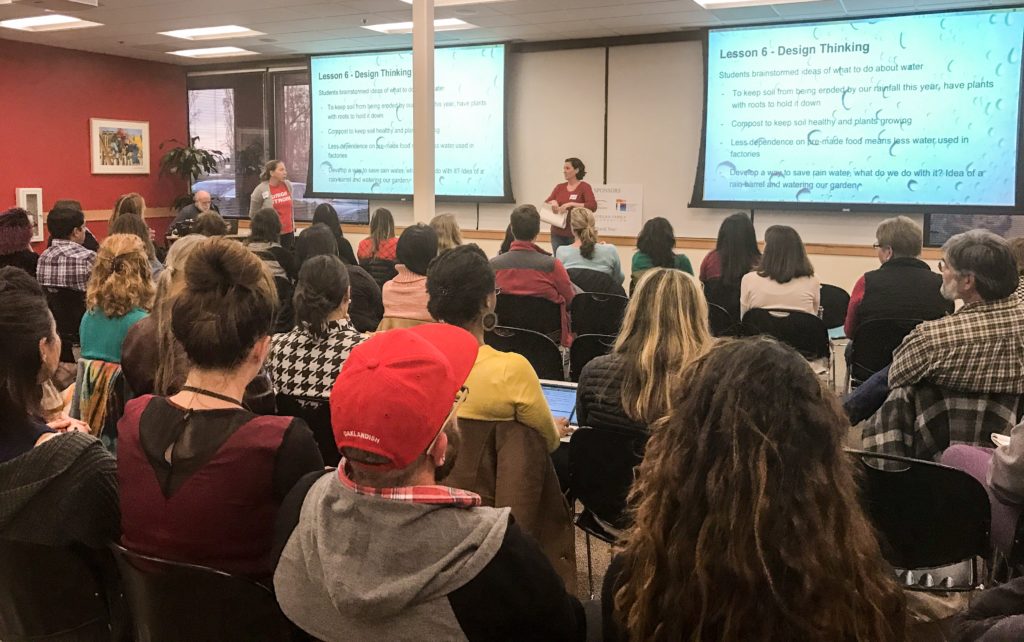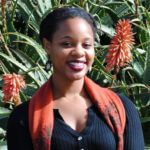“The students cleared a local pond that frequently gets clogged with natural or human-made pollution. On their return visit, they saw that a huge log had been thrown into the pond–but when they went to remove it, they found a thriving ecosystem of snails reclaiming the wood. So the students made the independent decision to leave the log undisturbed, as they had learned about snails’ vital impact as forest decomposers from their lessons!”
–Teacher from Berkwood Hedge School, Berkeley, CA
Having recently joined the team as Ten Strands’ newest member, the confluence of timing that allowed me to attend the capstone event for the 2016 San Mateo Environmental Learning Collaborative (ELC) was a perfect chance to see just what Ten Strands’ work looks like from a teacher’s perspective, such as that from the Berkwood Hedge teacher. Our team enjoys any opportunity to see how those experiences play out with students, so I was excited about the prospect.
The ELC is a professional learning experience where K–8 teachers develop and implement units of study, using humans’ original, most effective learning environment as context: nature. Teachers harvest content from instructional resources, such as the California Education and the Environment Initiative (EEI) Curriculum—the only State Board of Education approved K–12 environment-based curriculum in the country. The EEI Curriculum engages students in an environment-based, standards-aligned education in a way that builds crucial problem solving and social competencies.
Teachers who attend the ELCs work with county leaders, curriculum experts, and local environmental education providers to create engaging Next Generation Science Standards (NGSS) lesson plans that also teach important environmental concepts—inside and outside the classroom. The lessons created by teachers who attended this most recent ELC enable students to:
- Learn critical problem-solving skills using experiential, real-world situations
- Build fundamental science knowledge through empirical and analytical study
- Practice organizational project-planning techniques
- Synthesize and retain complex natural processes about the world around them, and connect the dots on how their actions can have positive or negative effects on natural resources used by humans and animals
- Engage in team-building projects that foster healthy, lifelong social skills, and self-empowerment
It sounds amazing; but what does this really look like for teachers and their students?
At the final capstone event for the 2016 San Mateo ELC, teachers presented their units and shared theirsuccesses and challenges after teaching a semester of standards- and environment-based lessons. The presentations were full of insight, hilarity, trial and error, fruitful collaborations between teachers and local environmental education providers, and, in one of my favorite comments from the teachers, renewed joie de vivre for teaching. At the heart of every story the teachers were excited that their students had become fully engaged learners when participating in outdoor lessons, in a unique way that was then supplemented inside the classroom.
The most integral takeaways from their experiences included:
ENGAGEMENT: All teachers raved about how student engagement dramatically increased during their units.
- Every teacher said that the outcome of retaining, synthesizing, and acting upon scientific concepts was successfully demonstrated by their students.
- Students not only became completely engaged learners while outside, but also tapped into their full potential as inquisitive individuals. One teacher exclaimed, “The students became very Zen when they were outside and exploring nature. They loved to be outside and wanted to learn more about what they found.”
COMMUNITY PARTNERSHIPS: Teachers found creative, community-focused ways to take their lessons beyond the classroom, and discovered that students would excitedly take ownership of their projects as well.
- Teachers who partnered with local environmental education providers found a rich, fun resource for incorporating Next Generation Science Standards into their lessons. Organizations such as the Marine Science Institute, CalRecycle, Hidden Villa, Vida Verde, CuriOdyssey, Pie Ranch, Project WET, Project Learning Tree, and RecycleWorks worked with teachers to get students to interact with their environment in ways that made lasting impressions.
- Students were actually excited to practice what they’d learned at home. Many teachers anchored their units in long-term plant-growing projects, which students enhanced with parent and guardian support. Another popular project was to implement a composting initiative. Teachers know that kids love to demonstrate mastery of physical activity, and students expanded their composting projects into school-wide initiatives, as well as composting in their own homes.
- Many teachers said that creating and organizing the lessons took a lot of work, but the academic successes and heightened engagement from their students made it worth it.
Lastly, there was one bright theme that ran through every teacher’s presentation. It’s an important concept that can be difficult to address in standards-based instruction, but is critical to early learning and social development:
EMPATHY.

Students learned best by understanding that nature is sentient, and that it is positively or negatively affected by how they use it, or what they put it into it.
- They learned via experiments and observation that nature is interconnected with everything. Hands-on experiences have longer sense memories than static lessons; watching a local pollinator (like Anna’s hummingbirds) drink nectar right before their eyes, or working in a garden and seeing it grow (or not!) enhanced their retention of lessons more deeply than solely reading a textbook.
- Students empathized with, and learned to assign biotic value to, animals that they considered pests (e.g. birds attacking their meals at lunch), whose behavior directly correlates to students’ actions; animals they thought of as dangerous (bees) were suddenly realized as crucial to the environment.
- In one powerful presentation from McKinley Elementary School in San Francisco, teachers instructed students to leave their lunch waste outside. When they revisited the area, it was mobbed by birds, whom they discovered—to their horror—had ingested plastic wrappings in order to get the food inside. That kind of lesson in personal responsibility is a tough but utterly effective way to teach about the human impact on the environment.
- Conversely, students LOVED having a positive effect on something’s life. They learned quickly when a plant died, or when their own actions (or more globally, human activity) had a visibly negative effect, and corrected their experiments accordingly.
- By using local environments, kids were better able to understand environmental processes because it related to something they experience daily (fog, precipitation, fish cycles, sewage systems). They felt confident and more connected to their communities by feeling they had mastered concepts that pertained to their lives.
As a newly-minted member of Ten Strands, I felt deeply empowered by the extraordinary capability demonstrated by these teachers. I was also proud of the local environmental education providers and our local public schools—of which I, too, am a direct beneficiary. Seeing photos of students clearly having a blast while learning about the environment and doing science, I felt lucky that my own love of nature was fostered by environment-based education in the Bay Area, an education that informs my decisions as an adult. The teachers participating in the ELC got to experience their students’ joy at mastering NGSS concepts, and their own professional development in creating versatile units of study that revitalized their idea of the classroom—which is to say, the classroom that is all around us.




